Introduction
The use of Dual Arch Trays was first described by Penslar A.[1] as early as 1971. Ever since a variety of dual arch trays like perforated plastic trays, perforated metal trays, plastic trays with reinforced fiber meshwork, metal trays with wire meshwork etc are available for clinical use. These trays are sectional. The Dual Arch Impression Technique was first published by Wilson and Werrin[2] in 1983. Randall and Lane[3] felt that dual arch trays greatly improve efficiency and patient comfort. Davis and Schwartz[4] published three articles as regarding the choice of trays, accuracy of casts from second pour and fit of restorations made on die obtained from dual arch trays. Breedy & Dixon[5] studied the dimensional accuracy of casts generated from impressions taken with different type of dual arch trays. Though several authors have described this dual arch technique, yet the use of these trays is not very popular. These trays can be suitably used with any type of elastomeric impression material but stiff- bodied rather than low viscosity impression materials are preferred to ensure tray rigidity. Elastomeric impression materials; Polyvinyl Siloxanes and Polyether Impression Material. This in vitro study was carried out to determine whether the dual arch plastic trays can generate sufficiently accurate impression that they can be used for obtaining dies required for precise fitting restorations. Plastic dual arch trays were used with clinically proven and routinely used Elastomeric impression materials. The comparison was made between the dimensions of machined stainless steel standard die and the dimensions of dies obtained. The null hypotheses was that there is no difference in dimensions of Gypsum dies made from various Elastomeric impressions in dual arch trays and the dimensions of standard stainless steel die.
Materials And Methods
A machined stainless steel circular die (Fig.1) (courtesy CTR, Ludhiana) representing a coronal tooth preparation was fixed in place of left Maxillary first molar. Sectional Plastic Dual Arch Trays (Capri India) were used with VPS, Aquasil Putty with Medium viscosity (Dentsply) ( Group I), VPS, Affinis Putty with Medium Viscosity (Coltene Whale dent) (Group II), VPS, Exaflex Putty with Medium viscosity ( G.C ) (Group III) and PE , Impregum Medium Viscosity (3M ESPE) (Group IV) (Fig 2). Twenty impressions with each type resulted in a total of eighty impressions. The dual arch trays were assessed for adequate typodont closure to maximum intercuspation without tray interference. A tray adhesive was not coated on the trays. Dual Mix technique was used with Four different impression material groups. One unit of each, the base and catalyst, of putty was mixed with hand and medium viscosity material was dispensed with auto mixing cartridges with tip. Impregum Monophase Medium Body material was dispensed with 3M ESPE Impression syringe. The tray was seated into maxillary left quadrant and Typodont was closed and 1.5 kg (Measured standardized) weight was used on the maxillary arm of the typodont simulating constant occlusal force. (Fig 3). A fabricated jig was used to stabilize the Tray position during polymerization of impression material, so that a reproducible position is attained during various impressions. The impressions were allowed to set for 12 minutes after the start of the mix, approximately double the manufacturers setting time guidelines to compensate for environmental variables After rinsing the impressions under running water for 10-15 seconds, they were poured in Type IV gypsum ( Synarock, DFS, Germany) with WP ratio of 20ml distilled water to 100 grams powder, was mixed for 1 minute and poured into tray being vibrated. The sequence of order of pour was randomized. The non working side of the impressions was poured first in first 10 impressions of each group and in rest of 10 the working side was poured first. The tray was supported in a Fabricated Jig. The opposing side was poured after initial setting of the first pour side with Type IV die stone (Synarock, DFS, Germany) Diamond Disc (DFS, Germany) was used to section the casts and form individual gypsum dies (Fig. 4). The bases of the dies were prepared using Model Trimmer and Sandpaper to obtain parallel walls. Eighty gypsum replicas of standard die were measured for Bucco lingual height (occluso- gingival), Bucco Lingual Diameter, Mesio Distal height (occluso - gingival) and Mesio Distal Diameter.
 | Fig 1
 |
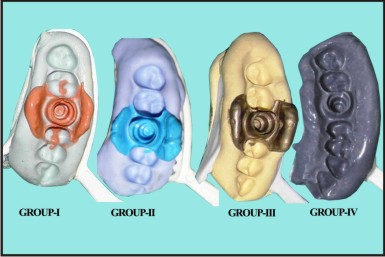 | Fig 2
 |
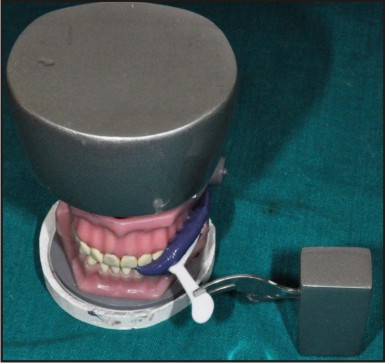 | Fig 3
 |
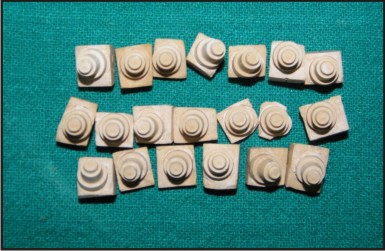 | Fig 4
 |
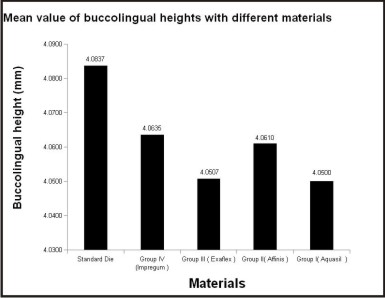 | Graph 1
 |
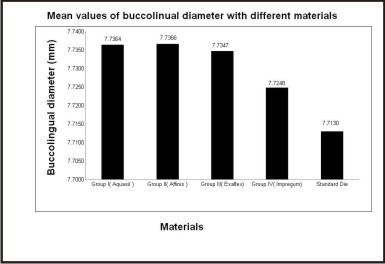 | Graph 2
 |
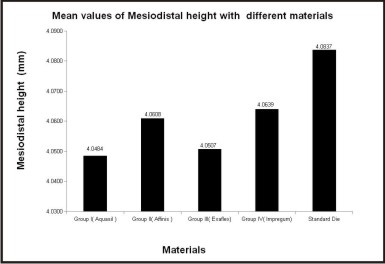 | Graph 3
 |
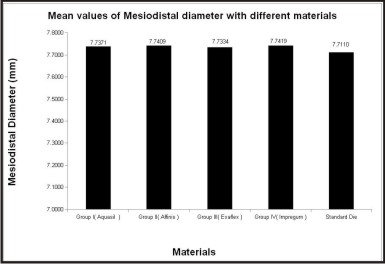 | Graph 4
 |
Measurement Of Dimensions
Customized die orientation was done using Mesio-distal and buccolingual marking for repeated measurements under microscope Measurements were done at Guru Nanak Dev Engineering College, Ludhiana with a Measuring Tool Makers Microscope (Carl Zeiss) Four aspects of the dies: Mesio-distal Diameter and Occluso Gingival Height, Buccolingual Diameter and Occluso Gingival Height were measured. Each Dimension was measured thrice and mean value was calculated. The same four aspects of the stainless steel standard die were measured multiple times before and after measuring all working dies.
Results
The average (mean & standard deviation) for each parameter is presented in Table 1 & Table 2. The effects of four main variables of type of the impression material for the tray were analyzed by means of Univariate ANOVA using a Tukeys Post Hoc Multiple Comparison test. P values less than 0.05 were considered statistically significant. The data was interpreted using SPSS (Statistical Package for Social Science, version 16) package.
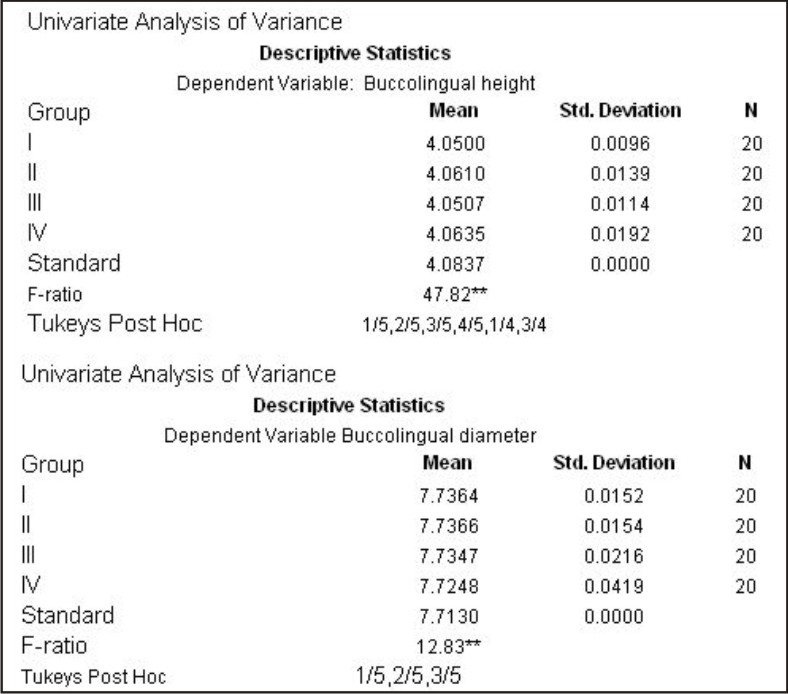 | Table 1
 |
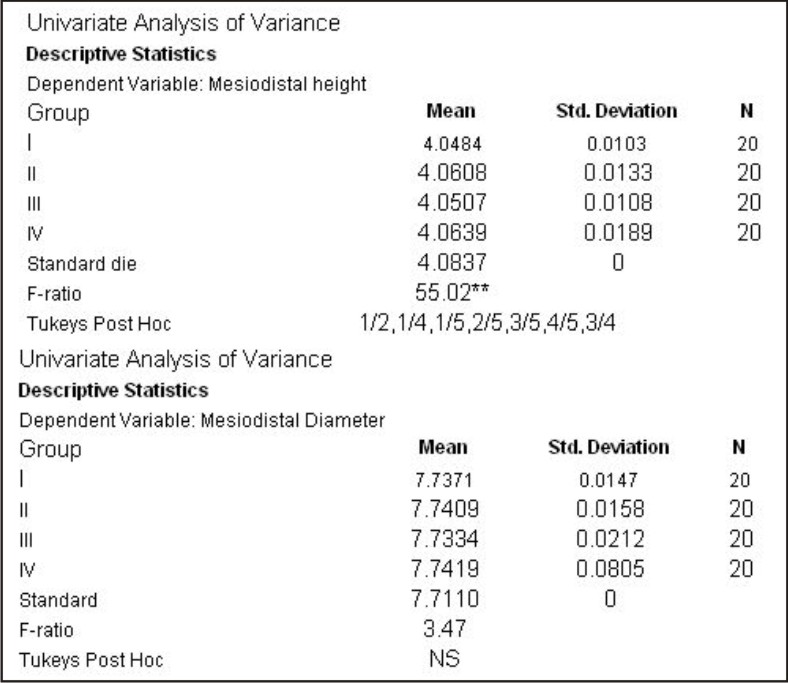 | Table 2
 |
Discussion
It is an established fact that for precisely fitting restorations, impressions must be accurate and this is one of the major factors that determine the longetivity of the restoration. The primary purpose of this study was to compare the accuracy of impressions made in Plastic Dual arch trays with either Vinyl Poly Siloxanes or Polyether impression materials. The comparison of impression materials was not the intention. However it was found that the impressions with Polyether material generated dies with greater success as compared to Vinyl Polysiloxanes. As many steps are involved in making indirect restorations, distortion at any stage can result in poorly fitting castings. Of the many variables, this study was focused on the type of impression trays used for recording impressions for single restorations. Flexibility of trays was definitely a matter of concern. However the putty consistency of the impression material provided required stability during its removal. Even without tray adhesive, material was well retained and no ‘peeling away’ was noticed in any of the samples. Greater force was required to remove the polyether impressions and there was concern about accuracy of dies. However the dies obtained from polyether impressions were dimensionally better than other materials. In this technique the closure path and force was standardized. Occlusal discrepancy in the resulting restoration due to the thin meshwork was not studied. The study did yield some statistically significant differences between materials. 23 micrometers was the greatest difference in the group mean values. However, the difference is clinically insignificant as the recommended luting consistency is 25 micrometers so the discrepancy can be managed. The study is applicable for impressions of single tooth restorations and with the same materials and consistencies. As the trays are sectional so the use is limited to single tooth impressions.
Conclusions
Following conclusions were drawn: The resulting dental stone dies obtained from the dual arch impressions measured smaller in heights and larger in Diameters than the control die. Though the difference was statistically significant yet clinically insignificant. The dual arch impression trays can be used with predictable results for single tooth restorations. However, for Fixed Partial Dentures or multiple single restorations it needs to be further studied. Polyether impression material resulted in dies with dimensions more close to the standard die.
References
1. Penslar AV. Combined bite and impression technique. Dent Dig. 1971; 77:454
2. Wilson EG, Werrin SR. Double arch impressions for simplified restorative dentistry. J Prosthet Dent 1983; 49:198-202.
3. Lane DA, Randall RC, Lane NS, Wilson NH. A Clinical trial to compare double –arch and complete arch impression techniques in provision of indirect restorations. J Prosthet Dent 2003; 89:141-145
4. Davis R, Schwartz R, Hilton T. Marginal adaptation of castings made with dual-arch and custom trays. . J Am Dent Assoc 1992; 5:253-4
5. Davis RD, Schwartz RS. Dual-arch and custom tray accuracy. J Am Dent Assoc
6. Breeding LC, Dixon DL. Accuracy of casts generated from dual –arch impressions J Prosthet Dent 2000; 84:403-7
|